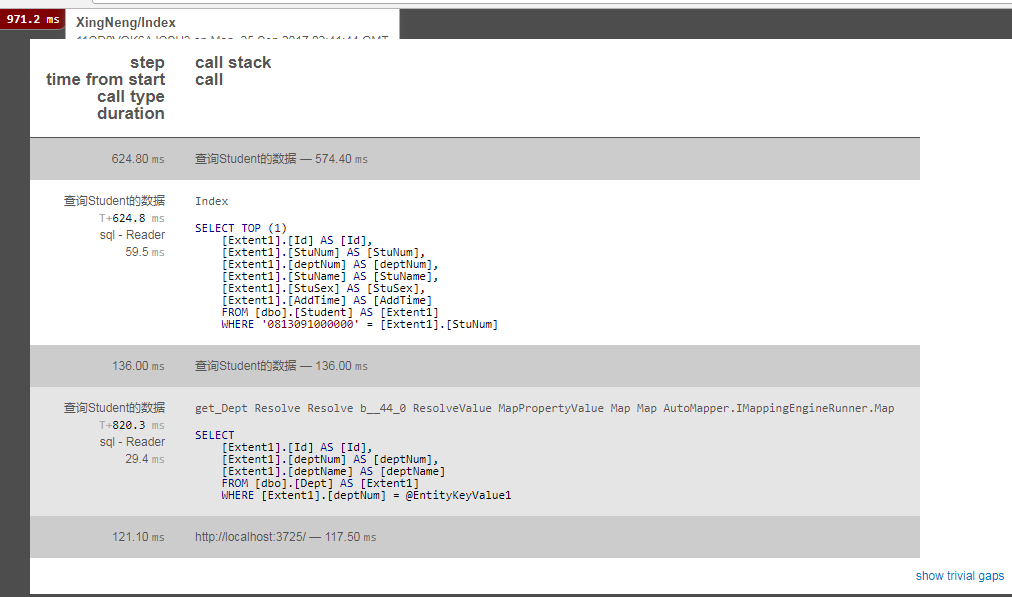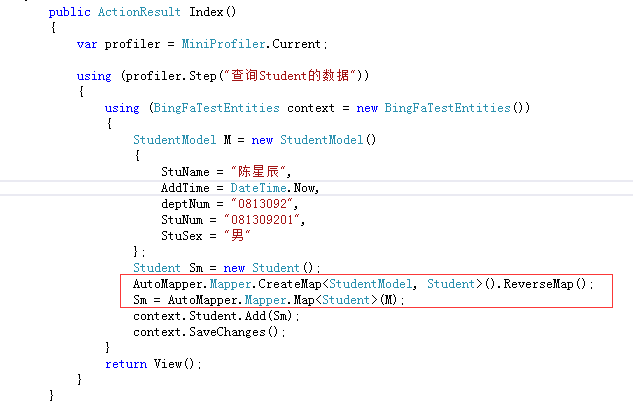AutoMapper自动映射
十年河东,十年河西,莫欺少年穷。
学无止境,精益求精。
不扯犊子,直接进入正题:
AutoMapper自动映射常用于EF中,能很好的解决DTO和Model之间相互映射的问题。在未使用AutoMapper之前,我们回顾下传统的对象相互映射的方法。
首先贴出本节要用到的DTO,学生表及系表,他们之间存在主外键关系!如下:

public partial class Dept { public Dept() { this.Student = new HashSet<Student>(); } public int Id { get; set; } public string deptNum { get; set; } public string deptName { get; set; } public virtual ICollection<Student> Student { get; set; } } public partial class Student { public int Id { get; set; } public string StuNum { get; set; } public string deptNum { get; set; } public string StuName { get; set; } public string StuSex { get; set; } public Nullable<System.DateTime> AddTime { get; set; } public virtual Dept Dept { get; set; } }
假设,现在要求将得到的学生对象转化为Model
新建学生对象Model

public class StudentModel { public int Id { get; set; } public string StuNum { get; set; } public string deptNum { get; set; } public string StuName { get; set; } public string StuSex { get; set; } public Nullable<System.DateTime> AddTime { get; set; } }
传统方法如下:

public ActionResult Index() { var profiler = MiniProfiler.Current; using (profiler.Step("查询Student的数据")) { using (BingFaTestEntities context = new BingFaTestEntities()) { var SM = context.Student.Where(A => A.StuNum == "0813091000000").FirstOrDefault(); if (SM != null) { var StudetM = new StudentModel() { Id = SM.Id, StuName = SM.StuNum, StuNum = SM.StuNum, StuSex = SM.StuSex, deptNum = SM.deptNum, AddTime = SM.AddTime }; } } return View(); } }
传统方法实现相互映射存在一个弊端,如果数据表字段特别多,那么,试问你需要写多少行代码?
OK,AutoMapper闪亮登场,那么如果使用AutoMapper需要写什么样的代码呢?

public ActionResult Index() { var profiler = MiniProfiler.Current; using (profiler.Step("查询Student的数据")) { using (BingFaTestEntities context = new BingFaTestEntities()) { var SM = context.Student.Where(A => A.StuNum == "0813091000000").FirstOrDefault(); if (SM != null) { StudentModel StudentM = Mapper.DynamicMap<StudentModel>(SM); } } return View(); } }
由上述代码可知,其相互映射只需一行代码搞定。这里需要注意,你定义的Model层个字段属性要和DTO层字段属性一致。
OK,那如果需要转化一个泛型集合呢?
传统方法如下:

public ActionResult Index() { var profiler = MiniProfiler.Current; using (profiler.Step("查询Student的数据")) { using (BingFaTestEntities context = new BingFaTestEntities()) { var SMList = context.Student.Where(A => A.StuName.Contains("陈")).ToList(); if (SMList != null&&SMList.Count>0) { foreach (var SM in SMList) { var StudetM = new StudentModel() { Id = SM.Id, StuName = SM.StuNum, StuNum = SM.StuNum, StuSex = SM.StuSex, deptNum = SM.deptNum, AddTime = SM.AddTime }; } } } return View(); } }
那么,AutoMapper是否可以做到呢?
当然,可以...

public ActionResult Index() { var profiler = MiniProfiler.Current; using (profiler.Step("查询Student的数据")) { using (BingFaTestEntities context = new BingFaTestEntities()) { var SMList = context.Student.Where(A => A.StuName.Contains("陈")).ToList(); if (SMList != null && SMList.Count > 0) { List<StudentModel> StudentM = Mapper.DynamicMap<List<StudentModel>>(SMList); } } return View(); } }
有上述代码可知,是不是连Foreach都省了?
哈哈,OK,这些都是些基础功能,咱们继续深究。
如果需要映射导航属性对应表中的字段怎么写呢?
我们将StudentModel修改成如下:

如果要得到系名称 deptName ,我们就要用到EF的懒加载。关于用EF懒加载时要注意的事项,大家可参考博客: EF性能优化-有人说EF性能低,我想说:EF确实不如ADO.NET,当然本节也会详细说明。
首先用传统方法实现如下:

public ActionResult Index() { var profiler = MiniProfiler.Current; using (profiler.Step("查询Student的数据")) { using (BingFaTestEntities context = new BingFaTestEntities()) { var SM = context.Student.Where(A => A.StuNum == "0813091000000").FirstOrDefault(); if (SM != null) { var StudetM = new StudentModel() { Id = SM.Id, StuName = SM.StuNum, StuNum = SM.StuNum, StuSex = SM.StuSex, deptNum = SM.deptNum, AddTime = SM.AddTime, deptName=SM.Dept.deptName }; } } return View(); } }

传统方法变化不大,那么,用AutoMapper怎么实现呢?

public ActionResult Index() { var profiler = MiniProfiler.Current; using (profiler.Step("查询Student的数据")) { using (BingFaTestEntities context = new BingFaTestEntities()) { var SM = context.Student.Where(A => A.StuNum == "0813091000000").FirstOrDefault(); AutoMapper.Mapper.CreateMap<Student, StudentModel>().ForMember(dest => dest.deptName, opts => opts.MapFrom(src => src.Dept.deptName)); var model = AutoMapper.Mapper.Map<StudentModel>(SM); } return View(); } }

由上述方法可知,使用AutoMapper方法进行映射,需要指定目标字段dest.deptName 以及 源字段 src.Dept.deptName,关于AutoMapper的详细用法及说明大家可参考:【来龙去脉系列】AutoMapper一款自动映射框架
在这里,我要告诫大家关于使用懒加载的注意事项,如果你不注意,那么你写的代码效率有可能将会非常低。
如上述两种方法,我们来监控下生成的SQL语句:(关于是如果监控生成的SQL语句,大家可参考我的博客:MiniProfiler工具介绍(监控EF生成的SQL语句)--EF,迷你监控器,哈哈哈)

生成了2条SQL语句:

OK,仅仅生成两条SQL语句还可以接受,但是如果你的项目数据表关系比较复杂,有很多导航属性时,就会生成很多SQL语句,会产生极大的性能问题。
那么关于懒加载的问题怎么解决呢?还好,EF中有Include,在使用Include时需要引入using System.Data.Entity;
将上边的程序修改成如下:

public ActionResult Index() { var profiler = MiniProfiler.Current; using (profiler.Step("查询Student的数据")) { using (BingFaTestEntities context = new BingFaTestEntities()) { var SMList = context.Student.Include(A=>A.Dept).Where(A => A.StuName.Contains("陈")).ToList(); AutoMapper.Mapper.CreateMap<Student, StudentModel>() .ForMember(dest => dest.deptName, opts => opts.MapFrom(src => src.Dept.deptName)); var modelList = AutoMapper.Mapper.Map<List<StudentModel>>(SMList); } return View(); } }

使用Include,其实相当于声明弃用懒加载,这里使用显示加载!
OK,关于使用AutoMapper应用懒加载的方法讲完了。正如上述所说:AutoMapper是将DTO映射成Model,如果反过来映射是否可行呢?
还好,AutoMapper提供了.ReverseMap();方法,将Model映射成DTO,如下:

public ActionResult Index() { var profiler = MiniProfiler.Current; using (profiler.Step("查询Student的数据")) { using (BingFaTestEntities context = new BingFaTestEntities()) { StudentModel M = new StudentModel() { StuName = "陈星辰", AddTime = DateTime.Now, deptNum = "0813092", StuNum = "081309201", StuSex = "男" }; Student Sm = new Student(); AutoMapper.Mapper.CreateMap<StudentModel, Student>().ReverseMap(); Sm = AutoMapper.Mapper.Map<Student>(M); context.Student.Add(Sm); context.SaveChanges(); } return View(); } }

OK。截止到这里,关于AutoMapper的基础用法也就讲完了,本人能力有限,如有未提及之处,请大家多多指点。希望大家喜欢!
@陈卧龙的博客








【推荐】国内首个AI IDE,深度理解中文开发场景,立即下载体验Trae
【推荐】编程新体验,更懂你的AI,立即体验豆包MarsCode编程助手
【推荐】抖音旗下AI助手豆包,你的智能百科全书,全免费不限次数
【推荐】轻量又高性能的 SSH 工具 IShell:AI 加持,快人一步
· Linux系列:如何用heaptrack跟踪.NET程序的非托管内存泄露
· 开发者必知的日志记录最佳实践
· SQL Server 2025 AI相关能力初探
· Linux系列:如何用 C#调用 C方法造成内存泄露
· AI与.NET技术实操系列(二):开始使用ML.NET
· 无需6万激活码!GitHub神秘组织3小时极速复刻Manus,手把手教你使用OpenManus搭建本
· C#/.NET/.NET Core优秀项目和框架2025年2月简报
· Manus爆火,是硬核还是营销?
· 终于写完轮子一部分:tcp代理 了,记录一下
· 【杭电多校比赛记录】2025“钉耙编程”中国大学生算法设计春季联赛(1)